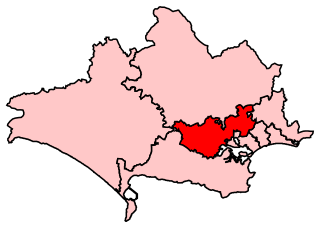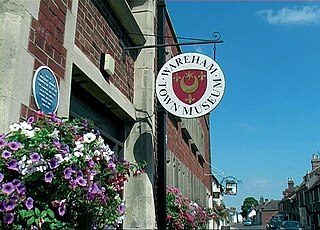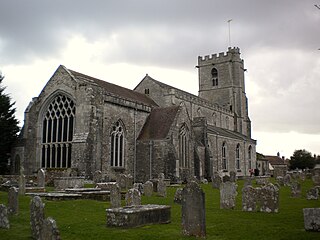Wareham Nunnery was a Benedictine nunnery in Dorset, England.
Wareham Nunnery was a Benedictine nunnery in Dorset, England.

Purbeck was a local government district in Dorset, England. The district was named after the Isle of Purbeck, a peninsula that forms a large proportion of the district's area. However, it extended significantly further north and west than the traditional boundary of the Isle of Purbeck which is the River Frome. The district council was based in the town of Wareham, which is itself north of the Frome.

Turners Puddle is a hamlet in Dorset, England, situated on the River Piddle in the Purbeck district, 7 miles (11 km) north west of Wareham. It used to be a civil parish in its own right, but now forms part of the civil parish of Affpuddle and Turnerspuddle, which also includes the settlement of Briantspuddle. In the 2011 census this joint parish had 200 households and a population of 436.

Mid Dorset and North Poole is a constituency represented in the House of Commons of the UK Parliament since 2015 by Michael Tomlinson, a Conservative.

Wareham railway station serves the town of Wareham in Dorset, England. It is situated about 0.6 miles (1 km) north of the town centre. It is 120 miles 70 chains (194.5 km) down the line from London Waterloo. On tickets it is printed "Wareham Dorset" to avoid confusion with Ware railway station.

Holton Heath railway station serves the area of Holton Heath in Wareham St Martin, Dorset, England. It is 118 miles 61 chains (191.1 km) down the line from London Waterloo. It was opened to serve the Royal Navy Cordite Factory, Holton Heath during the First World War. It did not open to the public until 1924.

Wareham St Martin is a civil parish in the English county of Dorset. The parish spreads across a large, and mostly rural area to the north of the town of Wareham including much of Wareham Forest. However the town of Wareham lies within its own civil parish, and the only significant settlement within Wareham St. Martin parish is the village of Sandford on the A351 road between Wareham and Poole. The parish also includes the Holton Heath trading estate.

Eadnoth the Younger or Eadnoth I was a medieval monk and prelate, successively Abbot of Ramsey and Bishop of Dorchester. From a prominent family of priests in the Fens, he was related to Oswald, Bishop of Worcester, Archbishop of York and founder of Ramsey Abbey. Following in the footsteps of his illustrious kinsman, he initially became a monk at Worcester. He is found at Ramsey supervising construction works in the 980s, and around 992 actually became Abbot of Ramsey. As abbot, he founded two daughter houses in what is now Cambridgeshire, namely, a monastery at St Ives and a nunnery at Chatteris. At some point between 1007 and 1009, he became Bishop of Dorchester, a see that encompassed much of the eastern Danelaw. He died at the Battle of Assandun in 1016, fighting Cnut the Great.

Ælfgifu of Shaftesbury was the first wife of King Edmund I. She was Queen of the English from her marriage in around 939 until her death in 944. Ælfgifu and Edmund were the parents of two future English kings, Eadwig and Edgar the Peaceful. Like her mother Wynflaed, Ælfgifu had a close and special if unknown connection with the royal nunnery of Shaftesbury (Dorset), founded by King Alfred, where she was buried and soon revered as a saint. According to a pre-Conquest tradition from Winchester, her feast day is 18 May.
The Lyman Reserve is a 210-acre (0.85 km2) nature reserve in Bourne, Plymouth and Wareham, Massachusetts and is managed by the Trustees of Reservations. There are 1.5 miles (2.4 km) of hiking trails, a beach and is in proximity to the Red Brook Reserve and Red Brook Wildlife Management Area. The area was formerly as private fishing camp, which sits at the mouth of Red Brook at Buttermilk Bay. It is home to one of the last remaining groups of sea-run brook trout ("salters") in the Eastern United States.

Wareham Town Museum tells the story of the Wareham area of Dorset in southern England from prehistoric times to the present day, with a special exhibition on Lawrence of Arabia, who lived nearby. The museum, which is in the centre of Wareham, in Wareham Town Hall, is supported by the Wareham Town Council and is run by volunteers.
Æthelstan Mannessune was a landowner and monastic patron in late 10th-century Anglo-Saxon England, coming from a family of secularised priests. Remembered by Ely Abbey as an enemy, he and his family endowed Ramsey Abbey and allegedly provided it with a piece of the True Cross. His children became important in their own right, one of them, Eadnoth, becoming Abbot of Ramsey and Bishop of Dorchester, and another becoming abbess of Chatteris nunnery.
Ælfwaru was an Anglo-Saxon noblewoman, who bequeathed her lands to churches such as Ely, and Ramsey. Chroniclers, writing in the 12th century, transcribed such bequests, from the original cyrographs. Ælfwaru's cyrograph has not survived. Ælfwaru's father, Æthelstan Mannessune, had two sons: Eadnoth, and Godric; and two daughters: Ælfwaru, and Ælfwyn.

Wareham Priory was a monastery in Dorset, England, possibly founded by the Saxons in 672 and dispersed during the Danish raids on Wareham in 876. It was refounded in 915 by Elfleda and probably dissolved in 998.
Leominster nunnery was an Anglo-Saxon nunnery at Leominster, Herefordshire, England. Founded in the ninth century, the nunnery is known to have been active in the eleventh century. The exact location of the nunnery is not known, but it may have been the site later occupied by Leominster Priory, a twelfth-century foundation.

Stainfield Priory was a Benedictine nunnery at Stainfield in the North of Lincolnshire, England, between Wragby and Fiskerton.
Stixwould Priory was a priory in Lincolnshire, England, a Cistercian nunnery founded by Lucy, countess of Chester, in 1135. The Mappa Mundi describes it as Gilbertine, but modern authors regard it as Premonstratensian. Originally suppressed in 1536, Benedictine nuns from Stainfield were then moved in by the King. In 1537 the nunnery was refounded for Premonstratensian canonesses, before being finally suppressed in 1539.

St Martin's Church, Wareham, sometimes St Martin's-on-the-walls, is an Anglo-Saxon church in the town of Wareham, Dorset in England. It is the most complete example of an Anglo-Saxon church in Dorset.

Hobarrow Bay is a small secluded southwest-facing bay, with an oil shale and shingle beach to the southeast of Brandy Bay and to the southwest of Kimmeridge on the south coast of the Isle of Purbeck, in Dorset, England.

The parish church of Lady St. Mary, Wareham is a church of Anglo-Saxon origin in the town of Wareham, Dorset, in England. The church is notable as the possible burial place of King Beorhtric, and for the discovery of five stones with Brittonic inscriptions dating to the 7th to 9th centuries. A notable feature is the unique hexagonal lead font dating to around 1200. The Anglo-Saxon nave was demolished in 1842.

Decoy Heath is an area of open heathland and bog forming part of Wareham Forest west of the Poole-Bournemouth conurbation in south Dorset, England. It is part of the Dorset Heaths.
Coordinates: 50°41′03″N2°06′28″W / 50.684289°N 2.107739°W